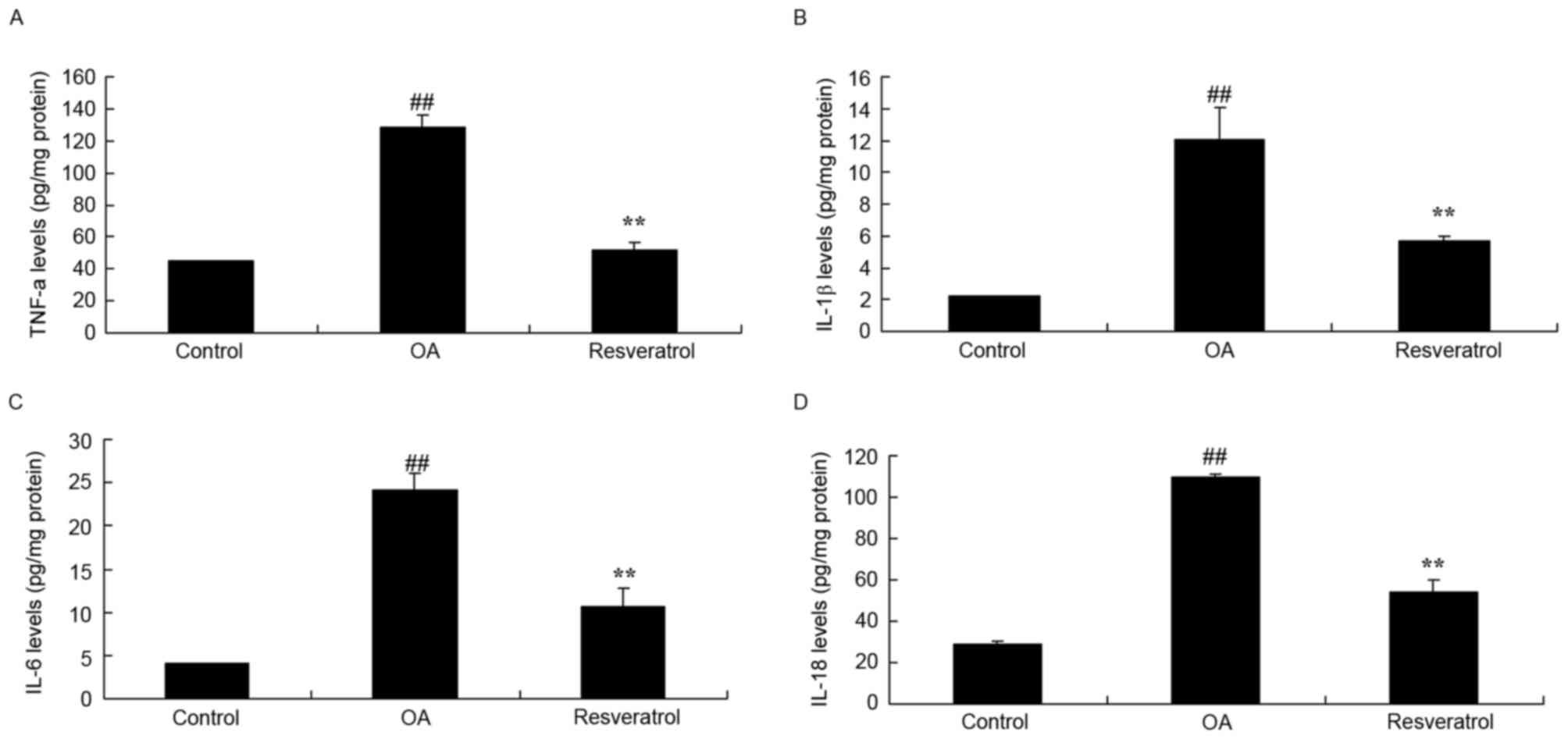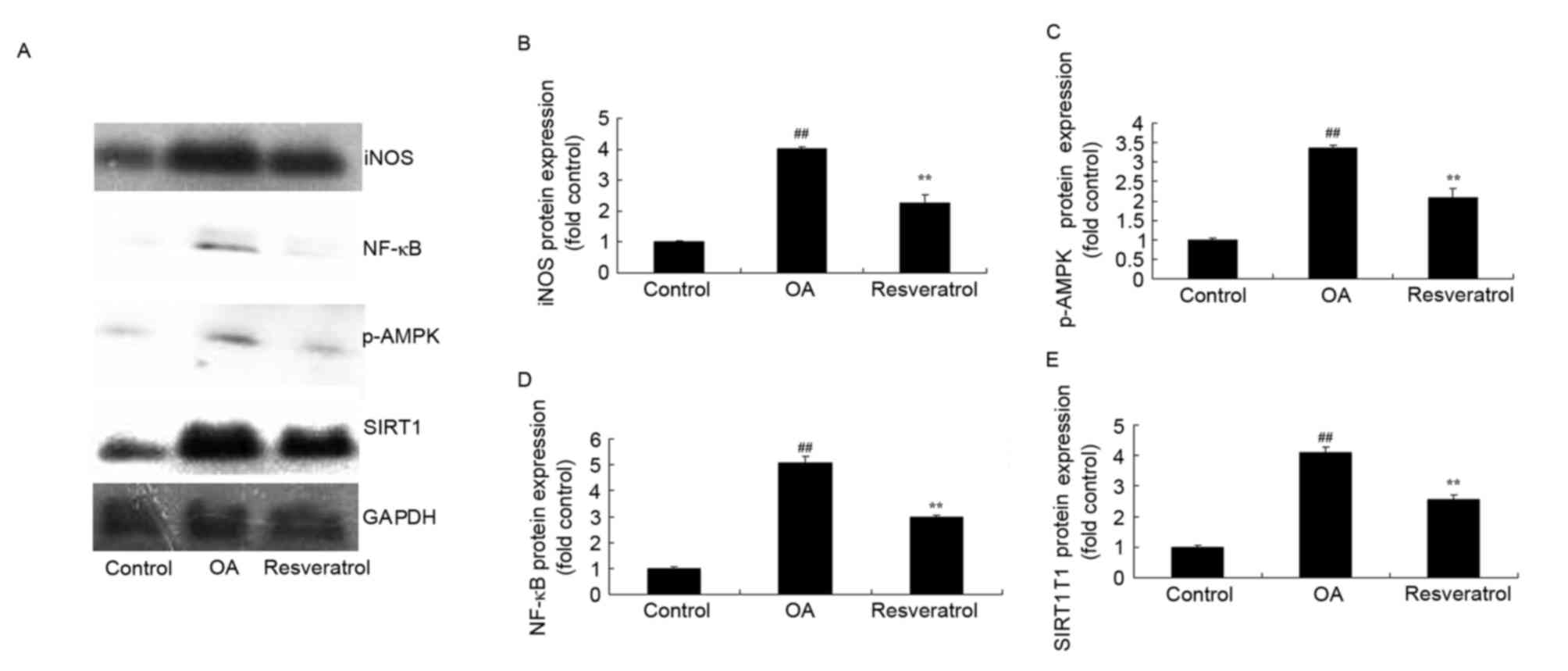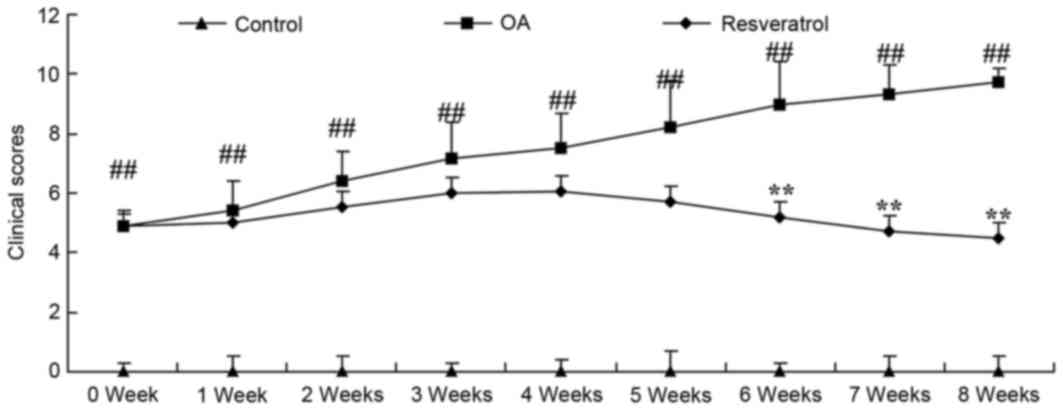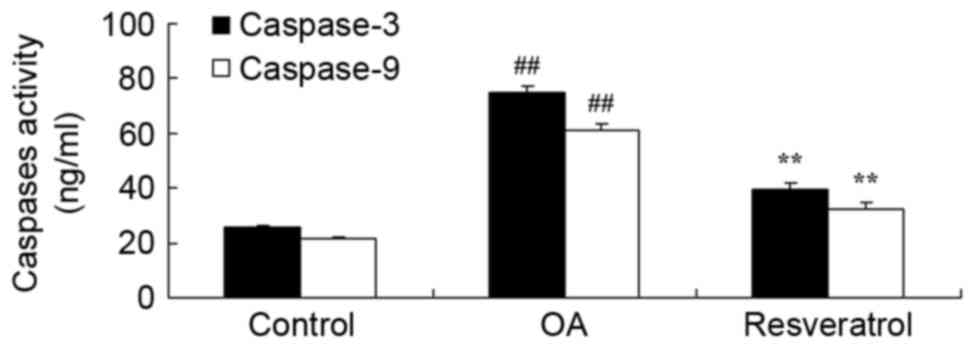Introduction
Osteoarthritis (OA) is a common chronic degenerative
joint disease, primarily characterized by degradation of cartilage,
synovitis and subchondral bone remodeling, it is a disease that
affects all joints in the body (1). The epidemiological survey did not
identify that OA had obvious racial and regional differences
(1). Arm arthritis accounts for
2–6% of disabilities in people aged >50 years, only secondary to
vascular diseases in terms of long-term disability (2). Due to high morbidity and disability
rates in the elderly, OA is considered to be one of the most common
diseases affecting human health (3).
Nuclear factor (NF)-κB, a nuclear factor that
specifically binds to the κB sequence of immunoglobulin K chain
gene enhancer, is the central transcription factor, which
participates in inflammation and the immune response. It is
activated by interleukin (IL)-1β, tumor necrosis factor (TNF)-α and
other cytokines, and rapidly induces the expression of multiple
genes, which participate in immune reactions and the inflammatory
response via a series of reactions, such as cytokine TNF-α, IL-1β,
IL-6 and IL-18, inflammatory enzyme and matrix metalloproteinase
(MMPs). Previous studies demonstrated that the NF-κB signaling
pathway was activated in a rat model of OA (4,5).
The imbalance of the oxidation-reduction reaction
leads to the accumulation of reactive oxygen species in the human
body, which eventually results in oxidative stress (6). Under oxidative stress,
large-molecular substances, such as proteins, lipids, DNA and RNA,
and particularly damaged protein, lose their normal functions and
their structures are impaired by oxidative damage (7).
Chondrocytes secrete more proinflammatory cytokines
due to pathological factors, among which TNF-α and IL-1β perform
the most important roles. These proinflammatory cytokines promote
the formation of MMPs and speed up the extracellular matrix
degradation of chondrocytes, significantly contributing to the
destruction of the articular cartilage (8). Due to congestion, edema and the
aggregation of inflammatory mediators, synovial inflammation
induces synovial cells to secrete a variety of proteases and
proinflammatory cytokines. Proteases, such as MMPS, contribute to
degradation of the articular cartilage. Proinflammatory cytokines,
such as TNF-α, IL-1β, IL-6 and IL-18 act on synovial cells and
chondrocytes to increase the secretion of MMPS, and inhibit the
synthesis of proteoglycan and collagen (9).
Resveratrol was first extracted from the root of
Veratrum grandiflorum by a Japanese man in 1940 (10). Resveratrol is the active
constituent of certain herbal medicines that treat inflammation,
lipid metabolism disorder and heart diseases (11). As an important secondary metabolite
of plants, resveratrol contributes to health care and a variety of
important biological functions (12). Resveratrol protects the
cardiovascular system by reducing myocardial ischemia reperfusion
injury, dilating blood vessels and preventing against
atherosclerosis (13). As
resveratrol dilates blood vessels, it lowers blood pressure and
reduces the risk of cardiovascular diseases (13). People have long used Polygonum
cuspidatum, Polygonum multiflorum and other traditional
Chinese medicines rich in resveratrol to treat and prevent against
hyperlipidemia and atherosclerosis (13). Recent studies have also indicated
that resveratrol is an effective constituent preventing against
cardiac dysfunction (13,14). Thus, the aim of the present study
was to determine the effects of resveratrol on inflammatory damage
in a rat model of OA, and its underlying mechanism.
Materials and methods
Animals
All animal procedures were approved by the Animal
Research Ethics Committee at Tongji Medical College (Wuhan, China).
Male Wistar rats (age, 6 weeks, n=30), weighing 200–230 g, were
purchased from Central Lab of Tongji Medical College (Wuhan,
China). Animals were maintained at Tongji Medical College (Tongji,
China) and housed three per cage in a room with controlled
temperature conditions (21–22°C), controlled lighting (12-h
light/dark cycle) and access to sterile food and water.
Induction of the OA model rat and
grouping
The animals were randomized and assigned to three
groups (n=10/per group) as follows: Sham group, OA model group and
resveratrol treatment group. Following anesthetization with
isoflurane (Sigma-Aldrich; Merck KGaA, Darmstadt, Germany), rats in
the OA model group and the resveratrol treatment group were
injected with intra-articular injection of monosodium iodoacetate
(Sigma-Aldrich; Merck KGaA) through the patellar ligament into the
intra-articular space of the right knee. Rats in the resveratrol
treatment group were administered with 50 mg/kg/3 days resveratrol,
for 8 weeks. Rats were sacrificed using decollation under 35 mg/kg
pentobarbital sodium (Sigma-Aldrich; Merck KGaA), after treatment
with resveratrol.
Clinical score of OA
A total score of 16 was recorded for each rat. The
clinical score was measured as follows: 0, No swelling; 1, ≥0.1 mm
increase in paw swelling or 1 digit; 2, ≥0.2 mm increase in paw
swelling and two groups of inflamed joints; 3, ≥0.3 mm increase in
paw swelling and two groups of inflamed joints; 4, ≥0.45 mm
increase in paw swelling and two groups of inflamed joints
(15).
Western blot analysis
Joint tissue samples were acquired from rats and
washed with PBS. Total protein of the tissue samples was extracted
using a protein radioimmunoprecipitation assay (Beyotime Institute
of Biotechnology, Nantong, China) and Protein concentrations were
measured using a Bicinchoninic Protein Assay kit (Beyotime
Institute of Biotechnology). Equal quantities (50 µg) of total
protein were separated by electrophoresis (80 V for 30 min and 120
V for 1 h) on 12% SDS-PAGE and electrophoretically transferred onto
polyvinylidene difluoride membranes. Membranes were blocked with 5%
skimmed milk in tris buffered saline with 0.1% Tween for 1 h at
37°C and incubated with NF-κB (cat. no. sc-56735, 1:1,000; Santa
Cruz Biotechnology, Inc., Dallas, TX, USA), p-AMP-activated protein
kinase (AMPK; 1:1,000; Santa Cruz Biotechnology, Inc.), sirtuin 1
(SIRT1; cat. no. sc-15404,1:1,000; Santa Cruz Biotechnology, Inc.),
heme oxygenase 1 (HO-1; cat. no. sc-10789, 1:1,000; Santa Cruz
Biotechnology, Inc.), nuclear factor erythroid 2-related factor 2
(Nrf-2; cat. no. sc-722, 1:1,000; Santa Cruz Biotechnology, Inc.)
and GAPDH (cat. no. sc-25778, 1:1,000; Santa Cruz Biotechnology,
Inc.) at 4°C after the membranes were washed with Tris-buffered
saline with Tween 20. Membranes were developed using an ECL
detection system (Beyotime Institute of Biotechnology) subsequent
to incubation with peroxidase-conjugated secondary antibodies (cat.
no. sc-2004, 1:5,000; Santa Cruz Biotechnology, Inc.) at 37°C for 1
h.
Statistical analysis
The results are presented as means ± standard
deviation. Statistical analysis was performed by one-way analysis
of variance for multiple comparisons and P<0.05 was considered
to indicate a statistically significant difference.
Results
Resveratrol ameliorates the clinical
scores in OA rat
There was a significant increase of clinical scores
in OA rats compared with the control group (Fig. 1; P<0.01). Treatment with
resveratrol significantly ameliorated the clinical scores in the OA
rats when compared with the OA model (Fig. 1; P<0.01).
Resveratrol ameliorates TNF-α, IL-1β,
IL-6 and IL-18 expression levels in OA rats
To investigate the protection mechanism of
resveratrol on OA rats, TNF-α, IL-1β, IL-6 and IL-18 expression
levels were measured. As shown in Fig.
2, TNF-α, IL-1β, IL-6 and IL-18 expression levels in the OA
rats were significantly increased compared with the control group
(Fig. 2; P<0.01). Treatment
with resveratrol significantly ameliorated TNF-α, IL-1β, IL-6 and
IL-18 expression levels in OA rats compared with the OA model rats
(Fig. 2; P<0.01).
 | Figure 2.Resveratrol ameliorates TNF-α, IL-1β,
IL-6 and IL-18 expression levels in OA rats. Resveratrol
ameliorates (A) TNF-α, (B) IL-1β, (C) IL-6 and (D) IL-18 expression
levels in OA rats Control, control group; OA, OA model group;
Resveratrol, resveratrol treatment group. ##P<0.01
vs. control group, **P<0.01 vs. OA model group. OA,
osteoarthritis. TNF, tumor necrosis factor; IL, interleukin; OA,
osteoarthritis. |
Resveratrol suppresses inducible
nitric oxide synthase (iNOS), NF-κB, p-AMPK and SIRT1 protein
expression levels in OA rats
To investigate the anti-inflammation effect of
resveratrol in OA rat, iNOS, NF-κB, p-AMPK and SIRT1 protein
expression levels were analyzed using western blotting. As shown in
Fig. 3, there were significant
increases in iNOS, NF-κB, p-AMPK and SIRT1 protein expression
levels in OA rats when compared with the control rats (P<0.01).
Treatment with resveratrol significantly suppressed the increased
levels of iNOS, NF-κB, p-AMPK and SIRT1 protein expression in the
OA rats, compared with the OA models (Fig. 3; P<0.01).
 | Figure 3.Resveratrol suppresses iNOS, NF-κB,
p-AMPK and SIRT1 protein expression in OA rats. (A) Representative
western blot images. Quantification of (B) iNOS, (C) p-AMPK, (D)
NF-κB and (E) and SIRT1 protein expression levels by resveratrol.
Statistical analysis was performed following western blot analysis
for iNOS, NF-κB, p-AMPK and SIRT1 protein expression in OA rats.
##P<0.01 vs. control group, **P<0.01 vs. OA model
group. OA, osteoarthritis; iNOS, inducible nitric oxide synthase;
NF, nuclear factor; AMPK, AMP-activated protein kinase; SIRT1,
sirtuin 1. |
Resveratrol inhibits
3,4-methylenedioxyamphetamine (MDA) and superoxide dismutase (SOD)
levels in OA rast
To further investigate the protection mechanism of
resveratrol on OA rats, SOD and MDA levels were measured using
ELISA kits. As presented in Fig.
4, OA effectively inhibited the SOD level and increased the MDA
level in OA rats, when compared with the control group. Treatment
with resveratrol significantly recovered the inhibited SOD level
and reduced the increased MDA level in the OA rat, compared with
the OA model (Fig. 4;
P<0.01).
Resveratrol induces HO-1 and Nrf-2
protein expression levels in OA rats
The effect of resveratrol on HO-1 and Nrf-2 protein
expression levels was evaluated in OA rats. As presented in
Fig. 5, HO-1 and Nrf-2 protein
expression levels were significantly lower in OA rats than in the
control rats (P<0.01). Treatment with resveratrol significantly
induced HO-1 and Nrf-2 protein expression levels in OA rats,
compared with the OA model (Fig.
5; P<0.01).
Resveratrol reduces caspase-3/9
activity in OA rats
The anti-apoptosis effects of resveratrol were
investigated in OA rats. As shown in Fig. 6, OA effectively induced caspase-3/9
activity in the OA rat models compared with the control group.
Treatment with resveratrol significantly reduced caspase-3/9
activity in OA rats compared with the OA model (Fig. 6; P<0.01).
Discussion
OA, one of the most common chronic bone and joint
degenerative diseases, may affect the joints of the limbs and
spine, with pathological characteristics, including lesions in
joint cartilage and subchondral bone (16). The clinical manifestations of OA
primarily include pain, stiffness, deformation and limited movement
of affected joints (17). Due to
the aging population in China, the incidence of OA is increasing,
with 50% of the population aged >60 years diagnosed with OA by
X-ray, of which 35–50% present with clinical manifestations, and
80% of the population >75-years-old present with OA symptoms in
China (18). In the current study,
resveratrol treatment was found to ameliorate inflammatory damage,
oxidative stress and neuronal apoptosis, and protect against OA in
rat models of OA. This is consistent with Pan et al
(12), who indicated that
resveratrol protects against neonatal brain injury following
hypoxia-ischemia via anti-apoptotic and anti-inflammatory effects
(12).
The pathogenesis of OA remains unclear, although it
has been confirmed that NO is significant in the incidence and
development of OA (19). NO, an
important regulatory factor participating in the differentiation
and apoptosis of chondrocytes, inhibits the proliferation of
chondrocytes and induces the apoptosis of chondrocytes. In
addition, NO suppresses the synthesis of proteoglycan and type II
collagen secreted by chondrocytes, and promotes the decomposition
of cartilage extracellular matrix (20). NOS is the key enzyme inducing NO in
patients with OA (9,20). Furthermore, the current data
indicates that resveratrol significantly suppressed the increased
levels of iNOS protein expression in OA rats. Wang et al
(19) reported that resveratrol
ameliorates the integrity of the blood-brain barrier by maintaining
iNOS expression.
Studies of AMPK predominantly focused on energy
metabolism, and very few studies investigate the association
between AMPK and inflammatory reactions (21,22).
However, increasing numbers of studies have demonstrated that AMPK
exerted anti-inflammatory effects. For example, AMPK is pivotal in
the regulation of energy metabolism in skeletal muscles, and is
involved in energy metabolism and inflammation of skeletal muscles
(23). In skeletal muscles, AMPK
exerts anti-inflammatory effects by inhibiting the expression level
of NF-κB (24). Activation of the
NF-κB signaling pathway, a pro-inflammatory signaling pathway in
the skeletal muscle cells of mice, may be inhibited by AMPK, and
peroxisome proliferation activated receptor inhibits skeletal
muscular inflammation and insulin resistance by inhibiting
endoplasmic reticulum stress via the AMPK-dependent signaling
pathway (22). In the present
study, resveratrol significantly suppressed AMPK protein expression
levels in OA rats. Meng et al (21) demonstrated that resveratrol
attenuated estrogen deficient-induced cardiac dysfunction through
enhancement of SIRT1/AMPK activity (21).
NF-κB is stimulated by various factors, such as TNFs
and ILs (24). Activated NF-κB
dissociates from its inhibitory proteins and translocates into the
nucleus from the cytoplasm, and binds to specific sequences (at the
κB site) of promoter/enhancer, located upstream of the NF-κB
signaling pathway, to adjust the expression levels of target genes
(19,24). The activated NF-κB signaling
pathway leads to the transcription of a series of downstream target
genes, resulting in associated biological effects, such as the
generation of inflammatory factors and the induction of chondrocyte
apoptosis (10). Furthermore,
resveratrol significantly reduced the level of NF-κB protein
expression in OA rats.
SIRT1 is expressed in human articular chondrocytes
and cartilage; however, its expression level in joint chondrocytes
is lower than that in normal chondrocytes of patients with OA
(25). In addition, it has been
found that SIRT1 promotes the expression of cartilage specific
genes, and enhances the anti-stress ability of chondrocytes,
promotes cell survival and inhibits chondrocyte apoptosis,
indicating that SIRT1 prevents against OA by inhibiting the aging
and apoptosis of chondrocytes (26). These findings indicate that
resveratrol significantly reduces SIRT1 protein expression levels
in OA rats. Gan et al (27)
demonstrated that resveratrol reduced acute kidney injury in septic
rats via SIRT1 and de-acetylated NF-κB-P65 (27).
HO-1/Nrf-2 has been confirmed to act against
oxidation, proliferation of malignant cells, apoptosis and
inflammation, indicating that HO-1/Nrf-2 is a protective molecule
in the body and has been used for the treatment of various diseases
(28). At present, studies
indicate that HO-1 alleviates lupus nephritis; an experimental
study with animal models of elastase-induced emphysema indicated
that gene therapy with adenovirus vector-mediated HO-1/Nrf-2
exerted a sound curative effect (29). In addition, HO-1/Nrf-2
gene-transfected chemical induction therapy and gene therapy are
effective in the treatment of heart and liver injury induced by
ischemia reperfusion, lipopolysaccharide-induced intraocular
inflammation and cardiac allograft rejection (30). By contrast, studies on patients
lacking HO-1/Nrf-2 indicated that HO-1/Nrf-2 deficiency may delay
and worsen inflammation (31).
Taken together, the current data suggests that resveratrol
significantly reduced caspase-3/9 activity in OA rats. Cheng et
al (32) reported that
resveratrol attenuates inflammation and oxidative stress via the
Nrf-2/antioxidant responsive element signaling pathway in
myocardial ischemia-reperfusion injury (32).
In conclusion, the current study demonstrated that
resveratrol ameliorates inflammatory damage, oxidative stress and
neuronal apoptosis, and protects against OA in rat models of OA,
via further suppression of NF-κB and activation of HO-1/Nrf-2
signaling. Thus, resveratrol may present as an effective
therapeutic strategy for patients with OA. However, this study only
used a rat model, and therefore requires further study in other
models or clinical trials.
References
|
1
|
Benazzo F, Perticarini L, Padolino A,
Castelli A, Gifuni P, Lovato M, Manzini C and Giordan N: A
multi-centre, open label, long-term follow-up study to evaluate the
benefits of a new viscoelastic hydrogel (Hymovis®) in
the treatment of knee osteoarthritis. Eur Rev Med Pharmacol Sci.
20:959–968. 2016.
|
|
2
|
Rini C, Porter LS, Somers TJ, McKee DC,
DeVellis RF, Smith M, Winkel G, Ahern DK, Goldman R, Stiller JL, et
al: Automated Internet-based pain coping skills training to manage
osteoarthritis pain: A randomized controlled trial. Pain.
156:837–848. 2015. View Article : Google Scholar :
|
|
3
|
Schmal H, Salzmann GM, Langenmair ER,
Henkelmann R, Südkamp NP and Niemeyer P: Biochemical
characterization of early osteoarthritis in the ankle.
ScientificWorldJournal. 2014:4348022014. View Article : Google Scholar :
|
|
4
|
Scanzello CR: Chemokines and inflammation
in osteoarthritis: Insights from patients and animal models. J
Orthop Res. 35:735–739. 2017. View Article : Google Scholar
|
|
5
|
Cicuttini FM and Wluka AE: Not just
loading and age: The dynamics of osteoarthritis, obesity and
inflammation. Med J Aust. 204:472016. View Article : Google Scholar
|
|
6
|
Hsu DZ, Chu PY and Jou IM: Daily sesame
oil supplement attenuates joint pain by inhibiting muscular
oxidative stress in osteoarthritis rat model. J Nutr Biochem.
29:36–40. 2016. View Article : Google Scholar
|
|
7
|
Li D, Xie G and Wang W: Reactive oxygen
species: The 2-edged sword of osteoarthritis. Am J Med Sci.
344:486–490. 2012. View Article : Google Scholar
|
|
8
|
Fu Y, Lei J, Zhuang Y, Zhang K and Lu D:
Overexpression of HMGB1 A-box reduced IL-1β-induced MMP expression
and the production of inflammatory mediators in human chondrocytes.
Exp Cell Res. 349:184–190. 2016. View Article : Google Scholar
|
|
9
|
Ma Z, Piao T, Wang Y and Liu J: Astragalin
inhibits IL-1β-induced inflammatory mediators production in human
osteoarthritis chondrocyte by inhibiting NF-κB and MAPK activation.
Int Immunopharmacol. 25:83–87. 2015. View Article : Google Scholar
|
|
10
|
Aggarwal BB, Bhardwaj A, Aggarwal RS,
Seeram NP, Shishodia S and Takada Y: Role of resveratrol in
prevention and therapy of cancer: Preclinical and clinical studies.
Anticancer Res. 24:2783–2840. 2004.
|
|
11
|
Wu C, Zhang Y, Shen Q, Zhou Z, Liu W and
Hua J: Resveratrol changes spermatogonial stem cells (SSCs)
activity and ameliorates their loss in busulfan-induced infertile
mouse. Oncotarget. 7:82085–82096. 2016.
|
|
12
|
Pan S, Li S, Hu Y, Zhang H, Liu Y, Jiang
H, Fang M, Li Z, Xu K, Zhang H, et al: Resveratrol post-treatment
protects against neonatal brain injury after hypoxia-ischemia.
Oncotarget. 7:79247–79261. 2016.
|
|
13
|
Gharaee-Kermani M, Moore BB and Macoska
JA: Resveratrol-mediated repression and reversion of prostatic
myofibroblast phenoconversion. PLoS One. 11:e01583572016.
View Article : Google Scholar :
|
|
14
|
Bai T, Hu X, Zheng Y, Wang S, Kong J and
Cai L: Resveratrol protects against lipopolysaccharide-induced
cardiac dysfunction by enhancing SERCA2a activity through promoting
the phospholamban oligomerization. Am J Physiol Heart Circ Physiol.
311:H1051–H1062. 2016. View Article : Google Scholar
|
|
15
|
Pan T, Chen R, Wu D, Cai N, Shi X, Li B
and Pan J: Alpha-Mangostin suppresses interleukin-1β-induced
apoptosis in rat chondrocytes by inhibiting the NF-κB signaling
pathway and delays the progression of osteoarthritis in a rat
model. Int Immunopharmacol. 52:156–162. 2017. View Article : Google Scholar
|
|
16
|
Lomonte AB, de Morais MG, de Carvalho LO
and Zerbini CA: Efficacy of triamcinolone hexacetonide versus
methylprednisolone acetate intraarticular injections in knee
osteoarthritis: A randomized, double-blinded, 24-week study. J
Rheumatol. 42:1677–1684. 2015. View Article : Google Scholar
|
|
17
|
Pfitzner T, Abdel MP, von Roth P, Perka C
and Hommel H: Small improvements in mechanical axis alignment
achieved with MRI versus CT-based patient-specific instruments in
TKA: A randomized clinical trial. Clin Orthop Relat Res.
472:2913–2922. 2014. View Article : Google Scholar :
|
|
18
|
Runhaar J, van Middelkoop M, Reijman M,
Willemsen S, Oei EH, Vroegindeweij D, van Osch G, Koes B and
Bierma-Zeinstra SM: Prevention of knee osteoarthritis in overweight
females: The first preventive randomized controlled trial in
osteoarthritis. Am J Med. 128:888–895.e4. 2015. View Article : Google Scholar
|
|
19
|
Wang J, Kalhor A, Lu S, Crawford R, Ni JD
and Xiao Y: iNOS expression and osteocyte apoptosis in idiopathic,
non-traumatic osteonecrosis. Acta Orthop. 86:134–141. 2015.
View Article : Google Scholar :
|
|
20
|
Balaganur V, Pathak NN, Lingaraju MC, More
AS, Latief N, Kumari RR, Kumar D and Tandan SK: Effect of
S-methylisothiourea, an inducible nitric oxide synthase inhibitor,
in joint pain and pathology in surgically induced model of
osteoarthritis. Connect Tissue Res. 55:367–377. 2014. View Article : Google Scholar
|
|
21
|
Meng Z, Jing H, Gan L, Li H and Luo B:
Resveratrol attenuated estrogen-deficient-induced cardiac
dysfunction: Role of AMPK, SIRT1, and mitochondrial function. Am J
Transl Res. 8:2641–2649. 2016.
|
|
22
|
Tang CH, Chiu YC, Tan TW, Yang RS and Fu
WM: Adiponectin enhances IL-6 production in human synovial
fibroblast via an AdipoR1 receptor, AMPK, p38, and NF-kappa B
pathway. J Immunol. 179:5483–5492. 2007. View Article : Google Scholar
|
|
23
|
Zhou Y, Liu SQ, Yu L, He B, Wu SH, Zhao Q,
Xia SQ and Mei HJ: Berberine prevents nitric oxide-induced rat
chondrocyte apoptosis and cartilage degeneration in a rat
osteoarthritis model via AMPK and p38 MAPK signaling. Apoptosis.
20:1187–1199. 2015. View Article : Google Scholar
|
|
24
|
Yan H, Duan X, Pan H, Holguin N, Rai MF,
Akk A, Springer LE, Wickline SA, Sandell LJ and Pham CT:
Suppression of NF-κB activity via nanoparticle-based siRNA delivery
alters early cartilage responses to injury. Proc Natl Acad Sci USA.
113:E6199–E6208. 2016. View Article : Google Scholar :
|
|
25
|
Oh H, Kwak JS, Yang S, Gong MK, Kim JH,
Rhee J, Kim SK, Kim HE, Ryu JH and Chun JS: Reciprocal regulation
by hypoxia-inducible factor-2α and the NAMPT-NAD(+)-SIRT axis in
articular chondrocytes is involved in osteoarthritis.
Osteoarthritis Cartilage. 23:2288–2296. 2015. View Article : Google Scholar
|
|
26
|
Fu Y, Kinter M, Hudson J, Humphries KM,
Lane RS, White JR, Hakim M, Pan Y, Verdin E and Griffin TM: Aging
promotes sirtuin 3-dependent cartilage superoxide dismutase 2
acetylation and osteoarthritis. Arthritis Rheumatol. 68:1887–1898.
2016. View Article : Google Scholar :
|
|
27
|
Gan Y, Tao S, Cao D, Xie H and Zeng Q:
Protection of resveratrol on acute kidney injury in septic rats.
Hum Exp Toxicol. 36:1015–1022. 2017. View Article : Google Scholar
|
|
28
|
Rousset F, Nguyen MV, Grange L, Morel F
and Lardy B: Heme oxygenase-1 regulates matrix metalloproteinase
MMP-1 secretion and chondrocyte cell death via Nox4 NADPH oxidase
activity in chondrocytes. PLoS One. 8:e664782013. View Article : Google Scholar :
|
|
29
|
Kyostio-Moore S, Bangari DS, Ewing P,
Nambiar B, Berthelette P, Sookdeo C, Hutto E, Moran N, Sullivan J,
Matthews GL, et al: Local gene delivery of heme oxygenase-1 by
adeno-associated virus into osteoarthritic mouse joints exhibiting
synovial oxidative stress. Osteoarthritis Cartilage. 21:358–367.
2013. View Article : Google Scholar
|
|
30
|
Aparicio-Soto M, Sánchez-Hidalgo M,
Cárdeno A, Rosillo MÁ, Sánchez-Fidalgo S, Utrilla J, Martín-Lacave
I and Alarcón-de-la-Lastra C: Dietary extra virgin olive oil
attenuates kidney injury in pristane-induced SLE model via
activation of HO-1/Nrf-2 antioxidant pathway and suppression of
JAK/STAT, NF-κB and MAPK activation. J Nutr Biochem. 27:278–288.
2016. View Article : Google Scholar
|
|
31
|
Clérigues V, Guillén MI, Gomar F and
Alcaraz MJ: Haem oxygenase-1 counteracts the effects of
interleukin-1β on inflammatory and senescence markers in
cartilage-subchondral bone explants from osteoarthritic patients.
Clin Sci (Lond). 122:239–250. 2012. View Article : Google Scholar
|
|
32
|
Cheng L, Jin Z, Zhao R, Ren K, Deng C and
Yu S: Resveratrol attenuates inflammation and oxidative stress
induced by myocardial ischemia-reperfusion injury: Role of Nrf2/ARE
pathway. Int J Clin Exp Med. 8:10420–10428. 2015.
|




















